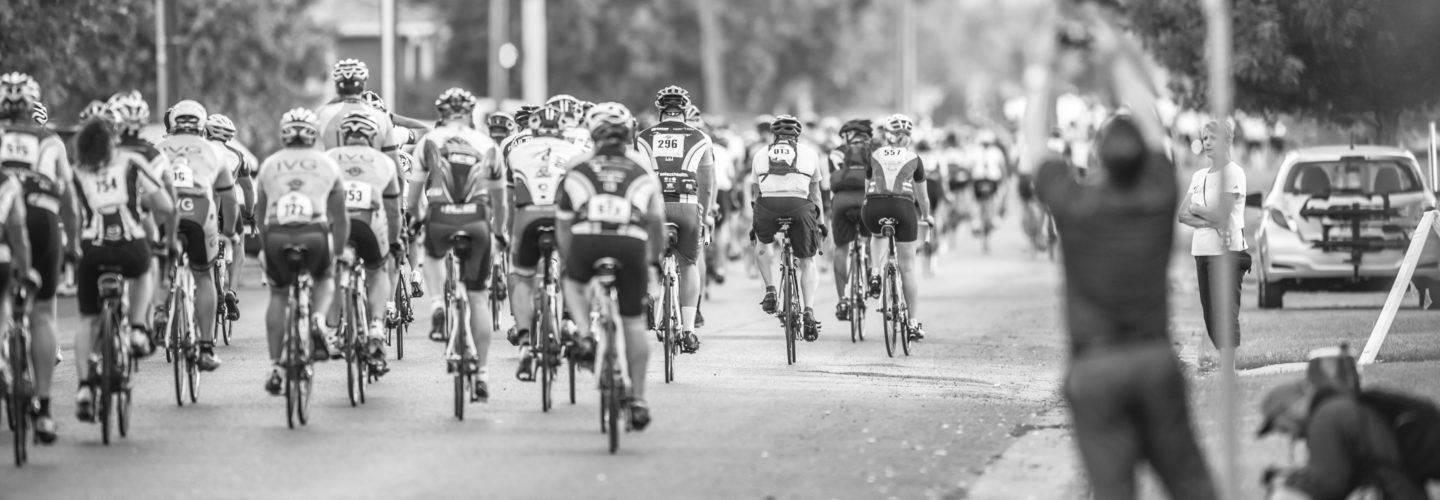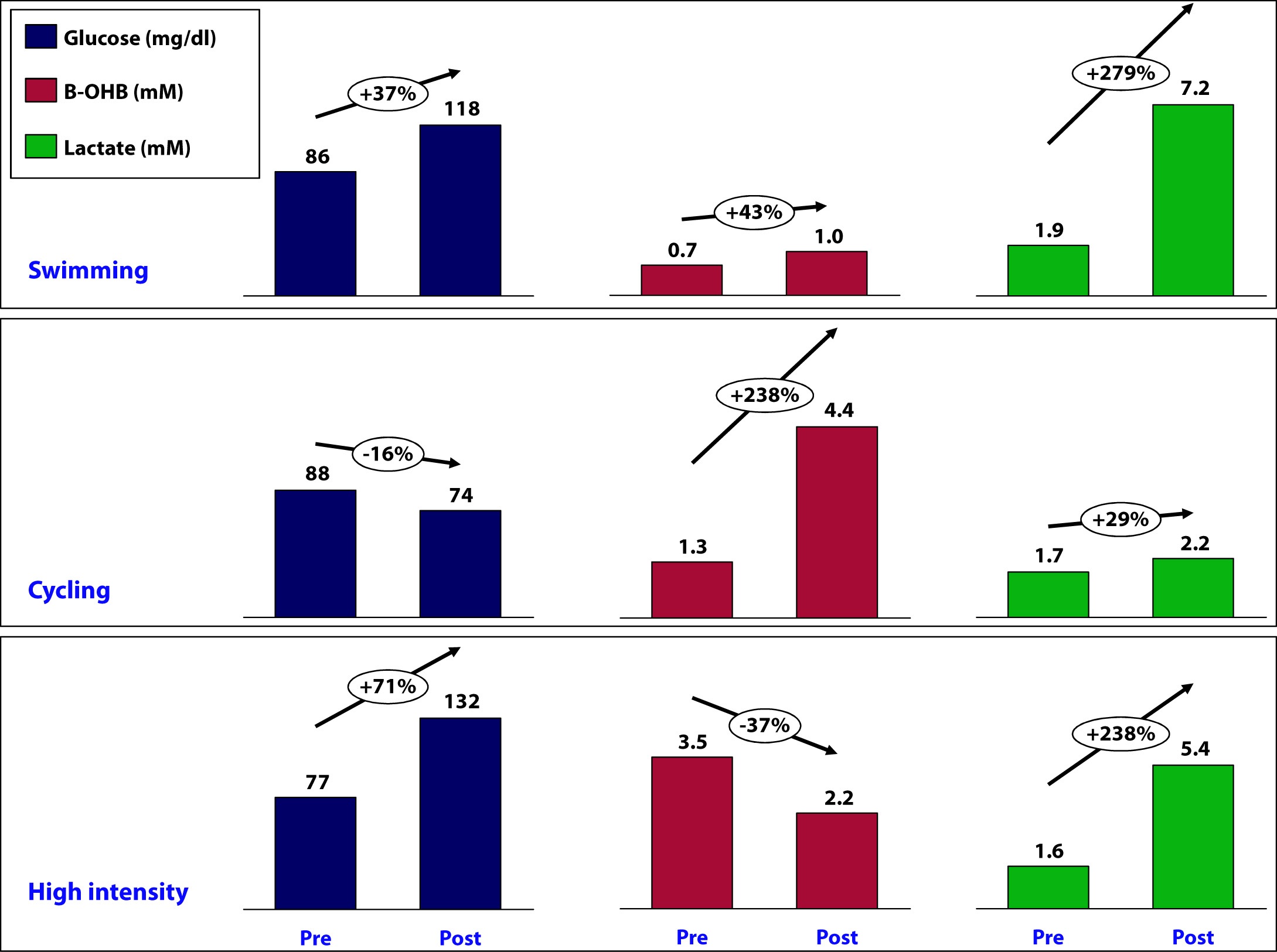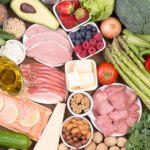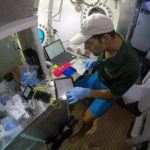You’ll recall from last week’s post I did a self-experiment to see if I could learn something about the interplay of exercise and ketosis, at least in myself. To understand this discussion, you’ll want to have read Part I of this post.
However, before getting to this, I want to digress and briefly address two unrelated issues:
- Some of you (about 67 or 68 as of this writing) have sent me various links to news reports released yesterday reporting on a study out of Harvard’s School of Public Health. I was planning to eventually write a post about how observational epidemiology is effectively at the heart of the nutritional crises we face – virtually every nutrition-based recommendation (e.g., eat fiber, don’t eat fat, salt is bad for you, red meat is bad for you) we hear is based on this sort of work. Given this study, and the press it’s getting, I will be writing the post on observational epidemiology next week. However, I’m going to ask you all to undertake a little “homework assignment.” Before next week I would suggest you read this article by Gary Taubes from the New York Times Magazine in 2007 which deals with this exact problem.
- I confirmed this week that someone (i.e., me) can actually eat too much of my wife’s ice cream (recipe already posted here –pretty please with lard on top no more requests for it). On two consecutive nights I ate about 4 or 5 bowls of the stuff. Holy cow did I feel like hell for a few hours. The amazing part is that I did this on two consecutive nights. Talk about addictive potential. Don’t say I didn’t warn you…
OK, back to the purpose of this post: How is ketosis impacting my ability to exercise? Here is the summary of the results from my personal experiment:
Let’s take a closer look at what may have been going on in each workout and see what we can learn.
Swimming
This workout probably produced the most lactate of the three workouts (we don’t know for sure because I only measured immediate pre- and post- levels without measuring in-workout levels). My glucose level rose by nearly 40% during this workout despite the fact that I did not consume anything.
How does this happen? Our bodies store glucose in the liver and in muscles in a “storage” form (a long chain of joined glucose molecules) called glycogen.
Whenever our bodies cannot access sufficient cellular oxygen, our metabolism shifts to a less efficient form of energy acquisition called anaerobic catabolism. During these periods of activity, we cannot oxidize fat or glycogen (i.e., use oxygen to harness the full chemical potential of fat or carbohydrate molecules). I will be writing in much more detail about these ideas in the next month or so, so don’t worry if these ideas seem a bit foreign right now. Just know that sometimes our bodies can convert fat or glucose to energy (efficiently), and sometimes we can only convert glucose to energy (inefficiently).
Because of my ketosis, and the metabolic flexibility that accompanies it, I only “require” that my body turn to glucose for energy under the most “stressful” forms of exercise – like I was doing a lot of during this workout. But keep in mind, my muscles CANNOT export one gram of the glucose they store, so any glucose in my bloodstream is either ingested (which I didn’t do) or coming from my liver, which CAN export glucose.
Furthermore, the stress of a workout like this results in my adrenal glands releasing a set of chemicals called catecholamines, which cause my liver to export even more of its stored glucose via a process called hepatic glucose output (HGO).
[As an aside, one of the major defects in type-2 diabetes is the inability of insulin to suppress HGO. In other words, even when not under the catecholamine stress that “should” lead to HGO, their livers constantly export glucose, which contributes to elevated blood glucose levels. The very popular drug, metformin, used often in type-2 diabetes, blocks this process.]
While I did experience a pretty large rise in lactate (almost 3x), my ketones still went up a bit. This could imply a few things:
- Elevated lactate levels do not directly inhibit beta-hydroxybutyrate (B-OHB)
- Mild elevations in glucose do not directly inhibit B-OHB
- Mild elevations in glucose do not directly inhibit B-OHB, if insulin is being suppressed (as is the case during vigorous exercise)
- B-OHB was suppressed, but we are only appreciating the net effect, which was a small increase (i.e., because of my MCT oil and activity, B-OHB levels were rising dramatically, but the rise was blunted by some other factor, such as HGO, insulin, and/or lactate)
More questions than answers from this workout, so on to the next workout.
Cycling
Despite this being a tough ride at several points, on average it was less stressful than the other two workouts and I spent the greater fraction of time in my aerobic to tempo (zone 2 to zone 3) zones.
A ride like this, however, is a great example of the advantages of improved metabolic flexibility that accompanies nutritional ketosis. My average heart rate during this 6 hour ride was 141. Prior to becoming ketotic, at a HR of 141 my respiratory quotient (RQ) was about 0.98, which meant I was almost 100% dependent on glycogen (glucose) for energy. Today, at a HR of 141 (with the same power output), my RQ is about 0.7 to 0.75, which means at the same HR and same power output as prior to ketosis, I now rely on glycogen for only about 10% of my energy needs, and the remaining 90% comes from access to my internal fat stores.
This is an important point. I will devote future posts to this topic in more detail, but I wanted to use this opportunity to mention it.
So what happened physiologically on this ride?
- My glucose levels fell, probably because I was slowly accessing glycogen stores for peak efforts (once my HR reaches 162 I become 50% dependent on glycogen) throughout the ride (e.g., peak climbing efforts, hard sections on flats), but my liver was not “called on” to dump out a massive amount of glucose in response to a catecholamine surge (and if it was, at some point during the ride, that amount of glucose had been used up by the time I was finished).
- B-OHB levels increased by about 2.5x – to 4.4. mM, which is pretty high for me. My highest recorded B-OHB level was 5.1 mM (also after a long ride). This confirms what my RQ data indicate — my body almost entirely relies on fat oxidation for energy for activity at this intensity. In the process, B-OHB is generated in large quantities, both for my brain and also my skeletal muscles (e.g., leg muscles). In reality, cardiac myocytes (heart muscle cells) also “like” B-OHB more than glucose and probably also access it when it is abundant.
- Lactate levels by the end of the ride were effectively unchanged though. Based on “feel,” I suspect I hit peak lactate levels of 8 to 10 mM on this ride during peak efforts, but I had ample time to clear it.
A few observations:
- I consumed 67 gm of carbohydrate on this ride (of which 50 gm was Generation UCAN’s super starch), yet this did not appear to negatively impact my ability to generate ketones. Technically, we can’t be sure this is the case, since I would have needed a “control” to know this (e.g., my metabolic and genetic twin doing and eating everything the same as I did, but without the consumption of super starch and/or without the bike ride). It’s possible that super starch did slightly inhibit ketosis and that my B-OHB level would have been, say, 5.0 mM instead of 4.4 mM. Metabolic studies of super starch show that it has a minimal impact on insulin secretion and blood glucose levels, hence the name “super” starch.
- Whatever impact peak levels of lactate production and hepatic glucose output had during the ride, they seem blunted by the end of the ride (and the ride did finish with a modestly difficult 1.4 mile climb at 6-7% grade, which I rode at a HR of about 150).
Since neither lactate levels nor glucose levels (nor insulin levels by extension) were elevated, I can’t really draw any conclusion about whether one factor, more than any other, suppressed production of B-OHB, so on to the next workout.
High intensity training
This sort of workout spans the creatine-phosphate (CP) system and the anaerobic energy system, and probably involves the aerobic energy system the least. I’ll write a lot about these later, but for now just know the CP system is good for very short bursts of energy (say 10-20 seconds) and recall the previous discussion of aerobic and anaerobic catabolism. In other words, this is the type of workout where my nutritional state of ketosis offers the least advantage.
- This workout saw the greatest increase in glucose level, about 70%. It is important to recall that during this workout I ingested water with a small amount of branched chain amino acids (BCAA’s – valine, leucine, isoleucine) and super starch, about 4 gm and 10 gm, respectively. I do not believe either accounted for the sharp rise in blood glucose and, again, I believe hepatic glucose output in response to a strong catecholamine surge attributed to this increase.
- Lactate levels also rose, though probably less so than during a peak swim effort. This suggests more of the effort in this workout was fueled by the CP system (versus the anaerobic system, which probably played a larger role in the swim workout).
- This was the only workout that saw a fall in B-OHB levels, which now offers some insight into what might be impacting B-OHB production.
Contrasting this workout with the swim workout draws a pleasant contrast: both saw a similar rise in lactate, but one saw twice the rise in blood glucose. In the former, B-OHB was unchanged (actually rose slightly), while in the latter, B-OHB fell by over a third.
This suggests – but certainly does not prove – that it is not lactate per se that inhibits ketone (B-OHB) production, but rather glucose and/or insulin. It is possible the BCAA played a role, and if I was thinking straight, I would not have consumed anything during this workout to remove variables. But I have a very hard time believing 3 or 4 gm of BCAA could suppress B-OHB. When you see hoof prints in the sand, you should probably think of horses before you think of zebras.
Conversely, there is some evidence that lactate promotes re-esterification of fatty acids into triglycerides within adipose cells. What does that mean in English? High levels of lactate take free fatty acids and help promote putting them back into storage form. This would prevent free fatty acids from making their way to the liver where they could be turned into ketones (e.g., B-OHB). In other words, we may be missing this effect because of my sampling error – I only sampled twice per workout, rather than multiple times throughout the workout.
So what did I learn, overall?
I think it’s safe to say I did not definitively answer any questions, which is not surprising given the number of confounding factors, lack of controls, and sample size of one. However, I think I did learn a few things.
Lesson 1
The metabolic advantages of nutritional ketosis seemed most apparent during my bike ride, evidenced by my ability to access internal fat stores across a much broader range of physiologic stress than a non-ketotic individual. (More on this in Lesson 4.)
Lesson 2
The swim and high intensity dry-land workouts suggested that my state of nutritional ketosis did not completely impair my ability to store or export hepatic glucose. This is a very important point! Why? Because, it runs counter to the “conventional wisdom” of low-carb (or ketotic) nutrition with respect to physical performance. We are “told” that without carbohydrates we can’t synthesize glycogen (i.e., we can’t store glucose). However, those who promote this idea fail to realize that glycerol (the backbone of triglycerides) is turned into glycogen, along with amino acids, not to mention the 20 to 40 gm of carbohydrates I consume each day (since my brain doesn’t need them). We know muscles still store glycogen in ketosis, as this has been well studied and documented via muscle biopsies by Phinney, Volek, and others. But, my little self-experiment actually adds a layer to this. Because muscle can’t export glucose (muscle lacks the enzyme glucose-1-phosphatase), we know that the increase in my blood glucose was accounted for by HGO – my liver exporting its glycogen. In other words, ketosis does not appear to completely impair hepatic glycogen formation or export. Again, we’d need controls to try to assess how much, if any, hepatic glycogen formation and/or export is inhibited. It’s hard to make the argument that being in ketosis is allowing me to swim and do high intensity training with greater aptitude, and as I’ve commented in the past, I feel I’m about 5-10% “off” where I was prior to ketosis for these specific activities, but at the same time, I could be doing more to optimize around them (e.g., spend less time on my bike which invariably detracts from them, supplement with creatine which may support shorter, more explosive movements), which I am not.
Lesson 3
Consuming “massive” amounts of super starch (50 gm on the ride), did not seem to adversely affect my ketotic state. My total carbohydrate intake for that day, including what I consumed for the other 18 hours of the day, was probably close to 90 gm (50 gm of super starch plus 40 gm of carbs from the other food I ate). This suggests one or two possibilities:
- Because of the molecular structure of super starch (I’ll be discussing this in the future, so please hold questions) and the concomitant metabolic profile that follows from this structure, it may not inhibit ketosis like other carbohydrate, and/or
- During periods of profound physical stress insulin secretion is being sufficiently inhibited that higher-than-normal amounts of carbohydrate can be tolerated without negatively impacting ketone production.
This is pretty straightforward to test, even in myself. I just haven’t done so yet.
Lesson 4
While it’s probably the case that my liver has less glycogen (i.e., stored glucose) at any point in time, relative to what would be present if I were eating a high-carb diet, it’s not clear this matters, at least for some types of workouts. Why? Take the following example:
- Someone my size can probably store about 100 gm of hepatic (liver) glycogen and about 300 gm of muscle glycogen at “full” capacity. This represents about 1600 calories worth of glucose – the most I can store at any one time.
- Before I was ketotic, my RQ at 60% max VO2 (about 2,500 mL of O2 per min consumption) was nearly 1.00, so at that level of power output (a pace I can hold for hours from a cardiovascular fitness standpoint) I required 95% of my energy to come from glycogen. So, how long do my glycogen stores last? 2,500 mL of O2 per minute translates to about 750 calories per hour, so I would be good for about 2 hours and 15 minutes on my glycogen stores.
- Contrast this with my ketotic state. Let’s assume my glycogen stores are now only half what they were before. Muscle biopsy data suggests this is probably an overly conservative estimate, but let us assume this to be the case. Now I only store 50 mg of hepatic glycogen and 150 gm of muscle glycogen, about 800 calories worth of glucose.
- In ketosis, my RQ at 60% max VO2 is 0.77 (at last check), telling me I am getting only 22% of my energy from glucose and the remaining 78% from fat. So, how long do my depleted glycogen stores last? Nearly 5 hours. Why? Because I barely access glucose at the SAME level of oxygen consumption and the same power output.
I know what you’re thinking…why is this an advantage? Just consume more glucose as you ride! It’s not that simple, but you’ll have to wait until my upcoming post, “What does exercise have to do with being in the ICU” to find out.
Going back to the black sheep example I open Part I of this post with, we know that at least one person in nutritional ketosis seems to make enough liver and muscle glycogen to support even the most demanding of his energetic needs.
Photo by Troy Oldham on Unsplash







Peter,
Since you mentioned the super starch, I decided to give it a try. I do a lot of heavy lifting and thought the extra carbs might help. So I have been drinking the 30g packet of super starch about a half hour before working out. My energy is up for the heavy lifting endurance work outs and I’m not feeling week on the big lifts. Push pressed 205lb today and it felt good. Although, we were doing heavy snatching yesterday, after snatching at the heaviest weight, I felt like passing out. I had to stand still and bend over to pull myself together. This has happened to me a few times when going very heavy on the ketotic diet. Just thought I would give the info to anyone interested.
Mark
Are you supplementing with an additional ~2 gm of sodium per day (i.e., at least 4 gm of total sodium per day)?
Peter,
I am taking at least 2 grams of salt per day via bullion. I’m not actively paying attention to salt intake beyond the 2g from bullion. I’m also taking 350mg potassium per day. I work out at 6am. My breakfast consists of 30g super starch per-workout, protein drink directly after workout and a cup of water and bullion about an hour after that. Sometimes I’ll have a heavy cream latte before the bullion. It is great that this blog has information about interplay of ketosis and working out. Thanks.
Mark
Try increasing the salt a bit and adding some magnesium.
Sorry, I take 350g magnesium and no potassium.
I mean 350mg of magnesium.
Peter, Before you totally eliminated carbohydrate from your diet,In time did you notice or feel as if you body was becoming more efficient at switching fuel source to stored adipose? I’ve gone no carb off and on for almost 3 months now with a weekly cheat of a quality beer and couple pieces of pizza or whatever I fancy. I have no proof but it feels as if my body is becoming more efficient to partioning fat for fuel. what do ya got? Thanks!
Absolutely. You do not need to be in ketosis to experience the benefits I’ve described. They will likely be less pronounced in most people, than in ketosis, but they are still absolutely present. The lower your average circulating insulin levels, the better your body is at mobilizing (rather than storing) fat.
Thanks again, Peter, for replying to my RQ questions. Now that I’ve had time to look around here more thoroughly (it takes awhile, there’s an amazing amount of information from your self-experiment!), I see that all of my questions were answered “in there”.
I also watched your presentation on JumpstartMD, and right now my number 1 project is to find out how the constant in the HOMA-IR equation is derived, because the rest of that equation uses fasting glucose and insulin, and yours were just fine, but that post-prandial insulin was killer (literally). A colleague and I were just laughing about how “evolved” a diabetes doc is that he reports to because at least he’s regularly ordering fasting insulin….sigh.
Thanks, too, for your hard work (and personal sacrifice I’m sure) for joining the roadshow that’s trying to change clinical medicine. The early pioneers like Atkins and the Eades, and even Barry Sears, had to take the heat alone. I really believe that with you joining Taubes, and Volek and Phinney and Westerman and the Eades and Lustig, the influence of the technically articulate may soon reach critical mass.
Dr. Attia, can you give me some idea of how you determine when you use UCAN and how much, with regard to cycling?
Highly variable and dependent on nutritional state. You’ll need to figure out what works for you. Start at, say, 25-35 gm/hour (much more than I use).
No surprise there… I’ve been <50g CHO for a little over a week… I have done up to 4hrs (Zone 2) without any supplementation. I read that Dr.Phinney does 3hr rides at 18-20mph without supplementing, but I didn't know if it was an intensity based thing. I live in the mountains and it's hard to do a ride and not get considerable Zone 4. Just trying not to shoot myself in the foot…
Dr. Attia, I apologize, I’ve botched this badly… What I was trying to ask is if there is a way that you know that you _need_ to supplement with UCAN? I know what it feels like to bonk… and I know what it feels like when I need to eat something when I’m not doing low carb… Is there a corresponding ‘feeling’ when in ketosis? I’ve not had any similar sensations despite riding what would have been long enough to induce them previously…
I don’t know how to answer this question? Need is a strong work. Certainly one doesn’t NEED much. It all depends on what you’re optimizing for and what your biologic characteristics are.
I’m sorry, I’m probably not being very clear… When you (Dr. Peter Attia) did the ride in this article, why did you supplement with UCAN? After you determined that you would need/want to supplement with UCAN, how did you decide on 50g?
Partly to conduct the experiment, party to augment some glycogen. I certainly didn’t “need” to to complete the ride.
Thank you, and thank you for your patience…
I just got back from a backcountry canoeing weekend, my first since going very low carb. I think I have some tweaking to do on this diet when it comes to my sport. Something about the upper body workout that paddling gives me makes my digestive process immediately cease – not good considering that most low carb food is heavy and slow to digest. Just a guess, but I think swimming could be similar. I haven’t experienced this type of stomach upset with sports that rely mostly on my legs, such as cycling.
I’m wondering about doing a liquid diet during the day and saving solid food for in camp at night. I don’t need to be in ketosis, but I like to stay around 30g of carb per day. Maybe a combo of UCAN, whey protein, and MCT oil. It’s hard to imagine paddling for 7-8 hours a day on this, but I’m willing to experiment.
On my trip over the weekend I ate grilled steak and chicken packed in ice, a lot of nuts and nut butter, cheese, and a few dried dates. Aside from the stomach upset, I was very happy with how the diet fueled my body – no flameouts, no carb cravings, and I only had to eat every 3-4 hours, instead of every 1-2 like I used to do when I fueled myself on carbs.
Great work. Keep tweaking away. I find that sodium by itself is not enough for me. Needs to be in liquid form, which is why I like the bouillon so much.
Hi Doctor, I looked through the Volek/Phinney book as you suggested, and I don’t see what type of potassium to use. Vitaminshoppe has citrate, chelate, gluconate, aspartate, chloride… I don’t know what to get or what a minimum, safe dose is for a petite person. Thank you for your help, maryann
Not exactly clear (to me, at least) which is best. I’d probably start with citrate, though. Of the “big 3” — sodium, magnesium, and potassium — that’s the order of importance, so if you get the first 2 right, you don’t need much (if any) supplemental potassium.
Do you have more details as to what exactly our bodies do with UCAN? Is the idea that it just digests so slowly that the insulin response at any given time is negligible? Or does it follow some different metabolic pathway ala fructose? I guess I’m just trying understand a carb that doesn’t affect blood sugar or insulin, as that seems somewhat contradictory.
Ultimately, exactly what we do with glucose, but just in a very SLLLOOOOOWWWW fashion. Think of super starch as a time-released glucose.
That is a great help; I will hold off. Thank you very much! maryann
I have taken up rock climbing since January, and noticed the following, after a few days of climbing in a row:
When I come down to the ground and rest in between climbs, there is a feeling that there is fire in my forearm muscles, my upper biceps and sometimes elbow joint (but not the actual joint it feels like the muscle around the joint) and pulsates as my blood pumps…
This will linger for a good 3 – 4 hours, and only stops happening when I take 4 – 5 days off
When I’m on the wall climbing it goes away and I dont feel any of the pain.
Lately I have noticed that I have been climbing less days in a row now before this begins occurring.
Im 6′ 2″, 177lbs, ~17.5% body fat, I eat less that 50g carbs a day, and am trying to reduce my protein intake, I’m down to about 140g, while filling the rest in with fat. I eat a good cup of sautee spinach with salt and half an avocado everyday. and using my fat reserves to climb lets me go for 2 – 3 hours sessions, with probably half of that sitting down resting, just have to make sure my heart rate doesn’t sky rocket doing new moves on the wall!
Do you have any idea what is causing this?
Am I simply having too much omega 6?
Does omega 3 counter balance omega 6 issues, or is omega 3 just a better substitute, ie 50 omega 6 is okay if I have 50 omega 3 to balance it?
Is there a nutrient that I am low on?
Lots of questions, thanks for all the great work you and Gary have done, and I hope you get a chance to answer some.
Mark, LOTS going on here. Tough for me to say. Consider getting the lipid test done for omega-3/6 (https://www.omega3test.com/).
I have a question about sodium which I guess is tangentially related to this topic.
I have been in ketosis for about two weeks now. I rarely go over 1700mg of sodium a day. My recent (3/9) metabolic panel showed my sodium at 141 mmol/L and potassium at 4.8 mmol/L … I work out about 6 days a week but do not push myself into Zone 4+ as much as I’m in Zone 3.
Are these numbers from the panel even relevant to your point about sodium? Given that I’m still borderline hypertensive I’m very wary of 4,000mg of sodium per day not knowing how much I’m passing in my urine.
If you’re not symptomatic at all (light-headed, cramping, etc.), hold off. I suspect at some point you may need it. I’ll still suggest 400 mg/day of Mg.
This is a little off topic, but about the ice cream (sorry-but you did mention it in the post). Xylitol is converted to glucose in rats (I assume in humans too?). I don’t know if the conversion to glucose is complete or partial and I don’t know how much is absorbed in our gut.It also has some inhibitory effect on ketogenesis in rats. Now your ice cream doesn’t have much xylitol in it but it must have an effect on someone trying to be in ketosis much of the time?
Xylitol’s inhibition of ketosis is probably subject dependent. Steve Phinney, for example, has some unpublished data (I think “n” was small, maybe 25, but I don’t recall), showing no inhibition, but I do believe (especially in large amounts) it might inhibit B-OHB formation. In some people more than others, of course.
Dr. Jeff Volek does a good job breaking down the benefits of UCan Super Starch in layman’s terms in this video:
https://www.youtube.com/watch?v=GNr2JwJ6ARE
Dr. Attia…I imagine this is a product you would use when you need to be at your peak performance, but not necessarily for everyday training?
Do you mean me personally or “one” in general?
You, personally. You mentioned you’d take on UCan’s benefits in a later blog, so I was just interested in how you currently consume the product. Thanks.
Super-intense activity where I want a little more glycolytic power. So I will use for any workout (swim, bike, lift), where the intensity is expected to be sufficiently above threshold for long periods of time.
re: MCT and ketones
I’ve seen the use MCTs promoted for Alzheimer’s patients because MCTs produce ketones. There’s a prescription “medical food” called Axona which is a caprylic acid-based product which purports to do the same thing. Can MCTs or Axona or coconut oil appreciably raise ketones without the patient also restricting carbs? That just sounds too good to be true: all the benefits of a ketogenic diet without the diet.
Not quite so simple. Consuming MCT oil does generate ketones, but it’s quite transient in the presence of a “normal” diet. I think the best of both is MCT plus a ketotic diet, especially if your goal is ward off diseases like cancer and Alzheimer’s disease.
I just have a quick question as to the effects of adhering to a low carb diet, IE 50g a day and carb loading the day of competition? Would that eliminate the metobolic benifits of the diet? Would it make all the low carb dieting during training worthless on your LDL, HDL and Triglycerides?
Two separate issues, here, I think. In terms of overall health, I think one day per week of adding back carbs probably has a small effect. However, what it “gives” you in glycolytic power, it might “take” from you in oxidative flexibility.
Hi Peter, Thanks for all your great work.
I had an interesting experience this past weekend regarding ketosis and exercise. I have been in ketosis for nine weeks now. I am moderately active (probably very active if compared to mainstream America – lots of fast-paced hill-walking and farm work) and relatively fit. 53 years old. On Sunday we cut firewood for the first time in 5 months. I ran the chainsaw for over two hours, putting it down only to refill the gas (once) or to thrown (mostly large)logs out of the way. Normally, doing this kind of intensive, heavy labor with no build-up would have laid me flat that afternoon. Instead, I felt like I had done nothing much at all, and still feel that way today. I find this remarkable. It makes me think that the low-carb diet has made a major difference in my joints – no stiffness! In addition to having made it so I just worked, steadily, and only quit when I did because I was worried about the consequences, given the lack of working-up to cutting wood slowly. I wasn’t ravenous for lunch, either. On carbs, I would have been shaky and desperate for food.
Kathy, this is great to hear!
Kathy,
I experience the same thing now. I used to really struggle with exercising, not doing work out type of exercising, but really anything physical, ie playing with the kids, working around the house. I would be wasted by the early evening and wake up with sore joints. I am only 40, so didn’t really think that this was normal. Now I work out every morning for an hour, I am still able to stay up late and get up early, I don’t have joint pain nor sore muscles. (but the lack of sore muscles probably means I am not working out hard enough)
This is ALL down to high fat, low carb. The fact that I am also losing weight makes it such a powerful path for me. There is no turning back for me. I have been doing low carb for 18 months, but high fat, low carb for a little over eight weeks.
Thanks, Peter and Travis for your responses.
Travis – I agree, no turning back. I can’t believe how much better I feel. I’ve lost 15 lbs and would like to lose another 10. Most people would have said I was “fine” before – I’m 5’9″ and weighed 167, with a fair bit of muscle – but I think when people said I looked “fine” they mean relative to how everyone else looks! I love losing the weight but I love even more how I feel and then when I think of what this means for my long-term health – there is definitely no turning back. I’m not sure if I’ll ever eat more than 20gms of carbs a day. I don’t miss them, which I find amazing. And, there are now FIVE people in my office following low-carb diets as a result of my talking about it and providing articles by Gary Taubes! This is a REALLY big deal, since I work in public health.
As a 260lb T2 Diabetic, I use a <30g a day ketogenic diet to successfully control my BG levels. Most of the time my BG remains below 100mg/dl, however I run 5k races every Saturday morning at about 93% max effort and find that my post-race BG can hit 180mg/dl or more, despite not injesting any food before the race.
Most references seem to suggest that the liver's glycogen supplies have to be exhausted before ketogenesis can commence, so I've been surprised that I can have such a spectacular liver dump while in ketosis.
Lesson 2 is therefore a great relief to me (although I'm less than thrilled at getting a huge BG spike because of exercise).
The great news is, that after 2 initial terrible weeks, I've managed to knock over 2 minutes off my 5k PB since going on a ketogenic diet!
Hi Peter,
I’ve read from many sources that while it takes the body some time to transition to ketosis, one bite of sugar or starch will throw you back into glycolysis. Is this true? If so, why would the body be so ready to abandon ketosis, especially because it is healthier?
Thanks!
It’s a great question! I have had “bad” meals that knock me out of ketosis for anywhere up to 2 days (that happened once). As we didn’t evolve in a food environment that looked anything like today, it might just be that we didn’t need to have this ability?